May the migrants survive the many new hazards in the south and continue returning each spring in the future, to contribute beauty and spirit to this northern wilderness. Adolph Murie (1963)
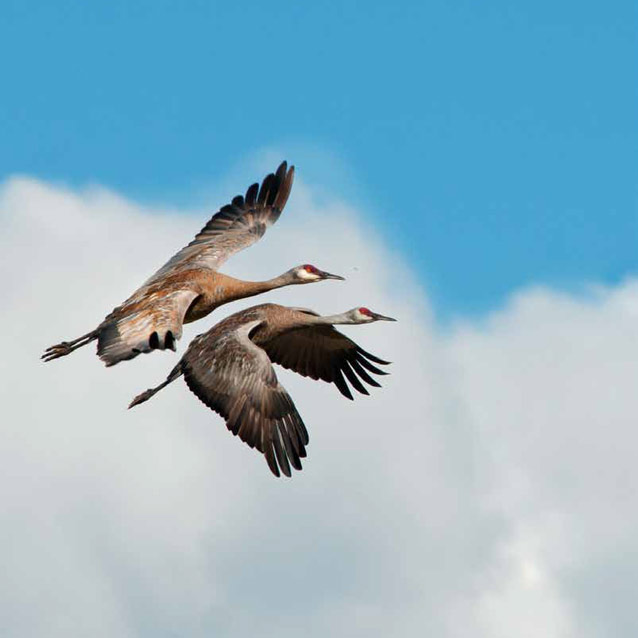
NPS Photo
Alaska is a land that showcases the important connections between migratory animals and people. Whether it is the excitement raised by seeing thousands of migrating sandhill cranes (Grus Canadensis) (Figure 1) returning in spring, the activities of preparing for fish camp or the anticipation of an upcoming caribou (Rangifer taradus) hunt, Alaskans are strongly tied to animal migration.
Visitors are also drawn to Alaska to see animal migration, and by observing and learning about these migrations they begin to understand some of the connections between where they live and some of Alaska’s migratory animals. Alaska’s national parks, encompassing nearly 54 million acres (about 22 million hectares), play an increasingly important role in conserving migratory animals, including migratory birds. Here, migratory birds that overwinter across the world return each spring to nest and raise their family. These include some of the longest distance migrants in the world such as the Arctic tern (Sterna paradisaea) and northern wheatear (Oenanthe oenanthe).
It may be that Alaska’s national parks provide critical nesting habitat for a greater abundance and diversity of migratory birds than nearly all the other National Park Service (NPS) areas in the United States. Nearly 80 percent of the bird species that nest in Alaska’s national parks are migratory, yet, while the NPS prepares to celebrate its centennial, we still lack some of the most fundamental ecological information about most of these species.
The Need for Information
Conserving migratory species is one of the greatest challenges facing the NPS, particularly as human activities spread across areas used by migratory animals (Berger et al. 2010). Migratory birds nesting in NPS areas present unique conservation challenges because they are influenced by conditions and events in more than one part of the world, including along their migration routes and wintering areas that are often thousands of miles away from their protected breeding grounds. For instance, the abundance of fish off the coast of Antarctica may influence the ability of Arctic terns to return to Denali and reproduce successfully.
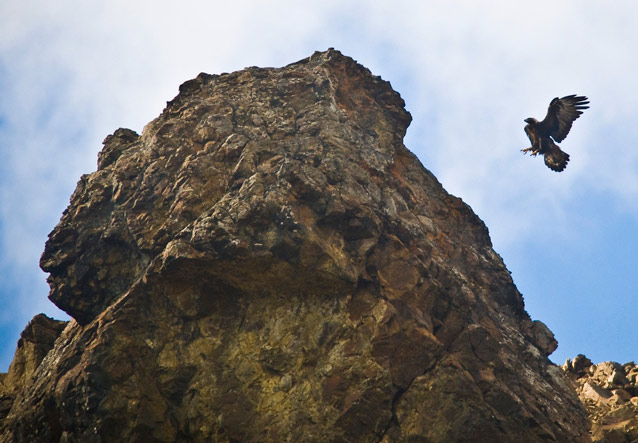
NPS Photo
Many migratory birds range across extraordinary distances and encounter a wide range of risks to survival and reproduction throughout their lifetime. Recent studies documented declining breeding populations of long-distance migratory birds (Both et al. 2006; Sanderson et al. 2006; Faaborg et al. 2010; Reif 2013). Recent evidence indicates that, in particular, mortality during migration may be a major demographic factor affecting population dynamics (Newton 2008; Faaborg et al. 2010). Even in Alaska, significant declines were documented in the reproductive success of golden eagles (Aquila chrysaetos) (Figure 2) (McIntyre and Schmidt 2012) and the abundance of Wilson’s warblers (Wilsonia pusilla) (Schmidt et al. 2013) in Denali National Park and Preserve (Denali). The causes of these recent declines are likely to be found either along their migration routes or on their wintering grounds.
A New Era of Tracking Birds Across Time and Space
The miniaturization of tracking devices in the early 1990s launched a new era of bird migration research and conservation efforts. The use of lightweight tracking units is changing some of the major assumptions about bird movements (McKinnon et al. 2013) and has challenged current paradigms about bird behavior in migration including sleep and dehydration (Gill et al. 2008). Satellite and GPS telemetry has greatly enhanced the study of bird migration in Alaska, allowing biologists to follow individual migratory birds where they travel and investigate their behavior, movement patterns, and seasonal distribution In the Alaskan Arctic, scientists used satellite telemetry to identify nonbreeding areas of declining eider species (Petersen et al. 1999; Phillips et al. 2006). Spectacled eiders (Somateria fischeri) (Figure 3) nest in remote coastal areas of western and northern Alaska. Dramatic declines in breeding populations prompted the listing of the U.S. population as threatened; however, little change had been occurring on their breeding grounds and scientists hypothesized that wintering area conditions may be affecting survival of eiders (Stehn et al. 1993). For over 100 years, the wintering areas of spectacled eiders were a complete mystery—scientists did not know their location. Researchers worked with engineers to develop small implantable satellite transmitters that wouldn’t interfere with the deep diving behavior of these sea ducks. The location data from tagged birds eventually revealed that the entire North American and Russian populations of spectacled eiders winter in polynyas, naturally occurring openings in the winter sea ice, in the Bering Sea (Petersen et al. 1999). Such a discovery would have been highly unlikely without the use of satellite telemetry.
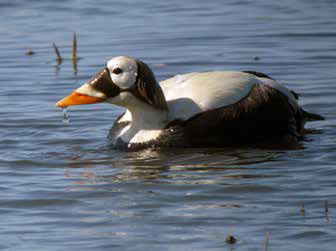
Courtesy Erik Hendrickson
In Denali, a three-year telemetry study of golden eagles revealed more about their movements than did 10-plus years of banding (Figure 4)(McIntyre et al. 2008) providing new information on annual ranges and survival. Previous studies had identified the importance of Denali as a nesting area for golden eagles (McIntyre and Adams 1999), but little information existed about their migratory paths or wintering areas. Study results showed that Denali’s golden eagles range over a vast area of western North America and that the probability of survival is much lower during autumn migration and early winter than during the rest of the year (McIntyre et al. 2006, 2008). Long-term monitoring of golden eagle populations at Denali has detected a decline in egg-laying and fledgling production (McIntyre and Schmidt 2012). Researchers suspect anthropogenic factors on the wintering ranges may be driving the decline (McIntyre and Schmidt 2012) and they are currently addressing some of those topics with new tracking studies.
Scientists have also used telemetry to identify sources of environmental contaminants in migratory birds in Alaska. For instance, USGS scientists used telemetry to study the blood lead concentrations in tundra swans (Cygnus columbianus) breeding in Alaska (Ely and Franson 2014). Like many species of waterfowl, tundra swans are susceptible to lead poisoning. While waterfowl may be exposed to lead by ingesting spent lead shot, they may also be exposed by ingesting fishing weights and other lead tackle, and when foraging in habitats exposed to sediments contaminated with lead by mining and smelting activities. Using satellite telemetry, researchers tested hypotheses related to possible relationships between blood lead concentrations and migratory movements. By marking tundra swans across Alaska, they found that differences in blood lead concentrations across breeding areas was likely influenced by differential exposure on staging and wintering areas (Ely and Franson 2014).
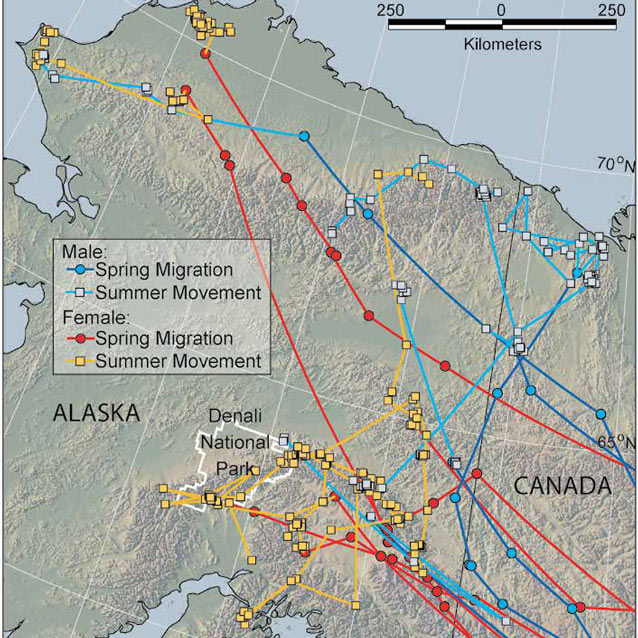
While these studies all highlight different aspects of bird ecology that have been answered using satellite telemetry, perhaps some of the most exciting results of studying bird migration using this technology comes from research on bar-tailed godwits (Limos lapponica baueri) breeding in Alaska. Here, researchers documented the amazing navigational abilities and endurance of these long-distance migrants (Gill et al. 2008). Before their research, the longest documented nonstop flight of any land bird was a distance of approximately 4,000 miles (6,437 kilometers) with an overwater crossing of about 2,800 miles (4,506 kilometers) completed in three to five days between Australia and China by far eastern curlews (Numenius madagascariensis) (Driscoll and Ueta 2002).
The bar-tailed godwits tagged by Gill et al. (2008) flew non-stop up to 4,600 miles (7,403 kilometers) and 9.4 days across the central Pacific Ocean from Alaska to New Zealand and eastern Australia. Further, their research showed that Pacific wind regimes presented bar-tailed godwits with numerous decisions related to when and where to fly during each of the three legs of their annual migration, and that the tagged birds were able to assess both the predictability and variability of atmosphere conditions, particularly wind (Gill et al. 2014).
New Tools for Tracking Smaller Birds
The development of small satellite and GPS transmitters was revolutionary technology that has provided phenomenal data about animal movements around the world. But, as small as some of the devices have become, they are still too large for many animals including many smaller migratory birds. The development of geolocators, archival light-recording devices that record light levels in relation to time allowing researchers to calculate latitude and longitude based on day length and sun elevation angle, has changed that situation. Currently, geolocators are small (0.02 ounces/0.75 grams) enough to be used effectively on warblers, and they are providing data that is challenging some of the long-held theories about bird migration as well as providing some amazing stories.
Banding studies and observations suggested Arctic terns (Figure 5) may undergo the longest seasonal movements of any species breeding in high latitudes of the northern hemisphere. Recent research using geolocators confirmed that Arctic
terns travel much farther than scientists originally thought, with some birds moving more than 49,700 miles (79,980 kilometers) annually from nesting areas in Greenland and the Netherlands to wintering sites in the oceans off Antarctica (Egevang et al. 2010; Fijn et al. 2013).
This study also identified a previously unknown oceanic hotspot foraging region of deep water in the eastern portion of the Newfoundland Basin and the western slope of the mid-North Atlantic Ridge, where the terns foraged for an average of 25 days before continuing their southward migration. Arctic terns are likely using global winds to reduce flight costs and complete the longest animal migration known in the world (Egevang et al. 2010).
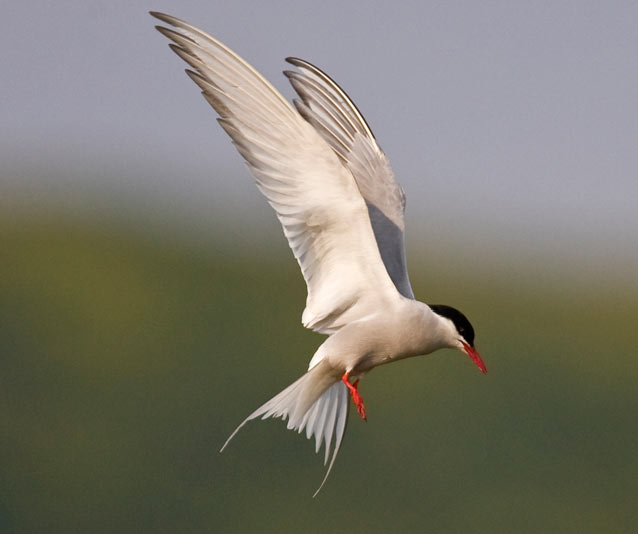
NPS Photo / Ken Conger
Geolocators have also provided surprising discoveries about large-scale bird movements outside migration. Declines in breeding populations of golden-winged warblers (Vermivora chrysoptera) prompted a study of their migration and overwintering ecology (Streby et al. 2015).
Researchers were astounded to find that after traveling 3,100 miles (4,989 kilometers) from their wintering areas in Colombia to their breeding grounds in eastern Tennessee, golden-winged warblers evacuated their breeding territories in apparent anticipation of an approaching storm system that spawned 84 confirmed tornadoes and caused more than $1 billion in property damage (Streby et al. 2015). During this period, the birds left their breeding territories and flew 930 miles (1,497 kilometers) in five days along routes that were similar to the northern portions of their fall and spring migration routes. The birds returned to their breeding territories after the storm system passed through the area.
Expanding Our Knowledge of Migratory Animals in Alaska’s National Parks
Results of these and many other studies clearly show that efforts to conserve migratory species in Alaska’s national parks must extend outside their boundaries. The NPS needs to greatly increase its efforts at understanding the movements of species outside park boundaries, identify important habitats and threats outside these boundaries, and work with partners at local, regional, national, and international scales to both identify and mitigate threats and protect the resources necessary for migratory species to persist.
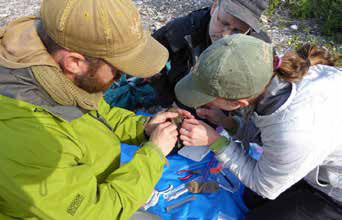
NPS Photo / Nina Chambers
With the support of the NPS, the Denali Education Center, and Alaska Geographic, we are launching the Critical Connections Program to expand our knowledge about the year-round needs of the migratory wildlife of Alaska’s national parks and to provide park managers and others with information essential for implementing effective conservation strategies for these migratory species. The first stage of the program focuses on:
- (1) studying the year-round movements of migratory birds that nest in Denali and assessing how conditions across their year-round range affect their ability to return to their northern breeding grounds and successfully produce young; and
- (2) building the Alaska National Parklands Migratory Animal Atlas, an online tool that will contain all available information about the migration routes, stopover areas, wintering areas, and conservation issues of migratory animals of Alaska’s national parks.
Alarming declines of many species of migratory passerine bird species in North America and elsewhere heighten the urgency of accurately mapping migration routes and wintering locations (Stutchbury et al. 2009). In the pilot year of the Critical Connections Program (2015), we along with our program collaborators Scott Weidensaul and Iain Stenhouse, captured and tagged 12 gray-cheeked (Catharus minimus) and 19 Swainson’s thrush (C. ustulatus) with lightweight geolocators (Figure 6).
These two species are long-distance migrants that commonly nest in Denali and winter in Central and South America. In 2016 we will recapture tagged thrushes to recover the geolocators and document their migration patterns and wintering areas. We will share results with other scientists studying the same and similar species to increase our knowledge of the migratory connectivity of these species. Another important component of the Critical Connections Program is the development of the Alaska National Parklands Migratory Animal Atlas. Through the atlas, we will provide NPS managers with the information they need to understand the complexities of animal migration and support conservation efforts while also providing the public with new and exciting information about animal migration.
We began working on the atlas by compiling information about migratory species in Denali to develop a bibliography of known information and identify data gaps. We will expand our efforts to include information about migratory species in all Alaska national parks.
Learn more by reading the in-depth Critical Connections 2015 Annual Report.
The Future
Understanding the factors influencing survival and reproduction of migratory birds has reached new levels of urgency, particularly with the mounting evidence that global climate change is currently affecting the timing and behavior of migration, and resource availability of migratory birds. The Critical Connections Program will provide new information for developing conservation strategies for the migratory birds that nest and use Alaska’s national parks, and open up new opportunities for learning more about the factors that affect survival and reproduction of migratory birds in Alaska’s national parks and collaborating with others to conserve migratory birds.
The members of the National Parks Science Committee challenged the NPS to make every conceivable effort to marshal the necessary resources to protect the integrity of our national parks and the life residing in them (National Parks Science Committee 2009). The Critical Connections Program will help us meet this challenge by expanding our scientific knowledge, increasing our capacity for place-based science and education, and strengthen our ability to protect the resources under our stewardship.
References
Both, C., S. Bouwhuis, C. Lessells, and M. Visser. 2006.
Climate change and population declines in a long- distance migratory bird. Nature. 441:81–83.
Driscoll, P., and M. Ueta. 2002.
The migration route and behaviour of eastern curlews (Numenius madagascariensis). Ibis. 144: E119-E130.
Ely, C., and J. Franson. 2014.
Blood lead concentrations in Alaskan tundra swans: linking breeding and wintering areas with satellite telemetry. Ecotoxicology. 23: 349-356.
Egevang, C., I. Stenhouse, P. Phillips, A. Petersen, J. Fox, and J. Silk. 2010.
Tracking of Arctic tern reveals longest animal migration. Proceedings of the National Academy of Science of the United States of America. 107: 2078-2083.
Faaborg, J., et al. 2010.
Conserving migratory landbirds in the New World: do we know enough? Ecological Applications. 20: 398-419.
Fijn, R., D. Hiemstra, R. Phillips, and J. van der Winden. 2013.
Arctic terns (Sterna paradisaea) from the Netherlands migrate record distances across three oceans to Wilkes Land, East Antarctica. Ardea. 101:3-12.
Gill, R., et al. 2008.
Extreme endurance flights by landbirds cross the Pacific Ocean: ecological corridor rather than barrier? Proceeding of the Royal Society B.
Gill, R., D. Douglas, C. Handel, T. Tibbitts, G. Hufford, and T. Piersma. 2014.
Hemispheric-scale wind selection facilitates bar-tailed godwit circum-migration of the Pacific. Animal Behaviour. 90: 117-130.
McKinnon, E., K. Fraser, and B. Stutchbury. 2013.
New discoveries in landbird migration using geolocators, and a flight plan for the future. The Auk. 130: 211-222.
McIntyre, C., and L. Adams. 1999.
Reproductive characteristics of migratory golden eagles in Denali National Park, Alaska. Condor. 115-123.
McIntyre, C., M. Collopy, and M. Lindberg. 2006.
Survival probability and mortality of migratory juvenile golden eagles from interior Alaska. Journal of Wildlife Management. 70:717-722.
McIntyre, C., D. Douglas, and M. Collopy. 2008.
Movements of golden eagles (Aquila chrysaetos) from interior Alaska during their first year of independence. The Auk. 125:214-224.
McIntyre, C., and J. Schmidt. 2012.
Ecological and environmental correlates of territory occupancy and breeding performance of golden eagles (Aquila chrysaetos) in interior Alaska. Ibis. 154: 124-135.
National Parks Science Committee. 2009.
National Park Service science in the 21st century. Second edition. Report D-1589A. Lakewood, CO: National Park Service.
Newton, I. 2008.
The migration ecology of birds. Salt Lake City: Academic Press.
Petersen, M., W. Larned, and D. Douglas. 1999.
At-sea distribution of spectacled eiders: a 120-year-old mystery resolved. The Auk. 116: 1009-1020.
Phillips, L., A. Powell, and E. Rexstad. 2006.
Large-scale movements and habitat characteristics of king eiders throughout the nonbreeding period. Condor. 108:887-900.
Reif, J. 2013.
Long-term trends in bird populations: a review of pat-terns and potential drivers in North America and Europe. Acta Ornithologica. 48: 1-16.
Sanderson, F., P. Donald, D. Pain, I. Burfield, and F. van Bommel. 2006.
Long-term population declines in Afro-Palearctic migrant birds. Biological Conservation. 131: 93-105.
Schmidt, J., C. McIntyre, and M. MacCluskie. 2013.
Accounting for incomplete detection: what are we estimating and how might it affect long-term passerine monitoring programs. Biological Conservation. 160: 130-139.
Stehn, R., C. Dau, B. Conant, and W. Butler Jr. 1993.
Decline of spectacled eiders nesting in western Alaska. Arctic. 264-277.
Streby, H., G. Kramer, S. Peterson, J. Lehman, D. Buehler, and D. Andersen. 2015.
Tornadic storm avoidance behavior in breeding songbirds. Current Biology. 25: 98-102.
Stutchbury, B., et al. 2009.
Tracking long-distance songbird migration by using geolocators. Science. 323: 896.
Part of a series of articles titled Alaska Park Science - Volume 14 Issue 2: Birds of Alaska's National Parks.
Last updated: October 23, 2021
